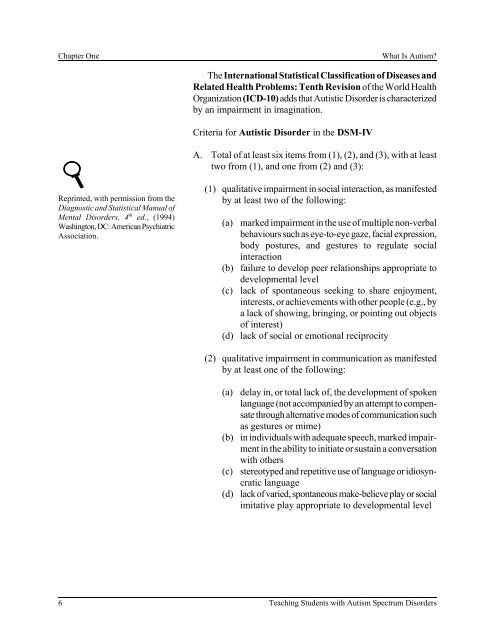Teaching Students with Autism Spectrum Disorders
Teaching Students with Autism Spectrum Disorders
Teaching Students with Autism Spectrum Disorders
Create successful ePaper yourself
Turn your PDF publications into a flip-book with our unique Google optimized e-Paper software.
Chapter One What Is <strong>Autism</strong>?<br />
Reprinted, <strong>with</strong> permission from the<br />
Diagnostic and Statistical Manual of<br />
Mental <strong>Disorders</strong>, 4 th ed., (1994)<br />
Washington, DC: American Psychiatric<br />
Association.<br />
The International Statistical Classification of Diseases and<br />
Related Health Problems: Tenth Revision of the World Health<br />
Organization (ICD-10) adds that Autistic Disorder is characterized<br />
by an impairment in imagination.<br />
Criteria for Autistic Disorder in the DSM-IV<br />
A. Total of at least six items from (1), (2), and (3), <strong>with</strong> at least<br />
two from (1), and one from (2) and (3):<br />
(1) qualitative impairment in social interaction, as manifested<br />
by at least two of the following:<br />
(a) marked impairment in the use of multiple non-verbal<br />
behaviours such as eye-to-eye gaze, facial expression,<br />
body postures, and gestures to regulate social<br />
interaction<br />
(b) failure to develop peer relationships appropriate to<br />
developmental level<br />
(c) lack of spontaneous seeking to share enjoyment,<br />
interests, or achievements <strong>with</strong> other people (e.g., by<br />
a lack of showing, bringing, or pointing out objects<br />
of interest)<br />
(d) lack of social or emotional reciprocity<br />
(2) qualitative impairment in communication as manifested<br />
by at least one of the following:<br />
(a) delay in, or total lack of, the development of spoken<br />
language (not accompanied by an attempt to compensate<br />
through alternative modes of communication such<br />
as gestures or mime)<br />
(b) in individuals <strong>with</strong> adequate speech, marked impairment<br />
in the ability to initiate or sustain a conversation<br />
<strong>with</strong> others<br />
(c) stereotyped and repetitive use of language or idiosyncratic<br />
language<br />
(d) lack of varied, spontaneous make-believe play or social<br />
imitative play appropriate to developmental level<br />
6 <strong>Teaching</strong> <strong>Students</strong> <strong>with</strong> <strong>Autism</strong> <strong>Spectrum</strong> <strong>Disorders</strong>

















